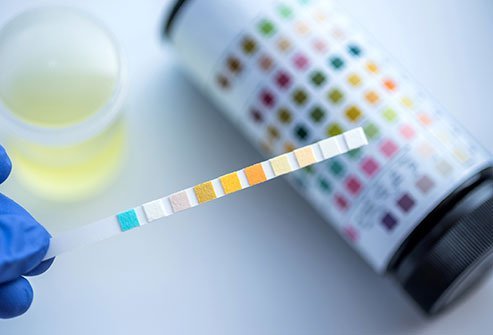What Does It Mean When Your Pee Is Green?

Green or blue pee is typically the result of consuming food that contains dyes or taking medications, such as the following:
- Propofol (an anesthetic agent given before surgery)
- Promethazine (used in the treatment of allergic conditions)
- Amitriptyline (antidepressant)
- Indomethacin (painkiller)
- Cimetidine (used in the treatment of acid peptic disorders)
Some imaging tests and treatments use a dye, such as methylene blue, which can also result in greenish urine. Tests that use dye, such as iodine-based contrast in the diagnosis of kidney and bladder conditions, may cause pee to turn blue.
However, some diseases, such as chronic obstructive jaundice and urinary tract infections, caused by the bacteria Pseudomonas can also turn the color of your urine green. So, consult your doctor if you have not eaten any food or taken medication known to cause greenish-looking urine.
What is the normal color of urine?
The normal color of urine is pale yellow, though it can be deep amber or dark yellow if you have consumed less water throughout the day or if you have become dehydrated due to conditions such as diarrhea.
You may also experience clear urine if you have taken in more fluids during the day than needed or if you are on a diuretic pill. If you have been experiencing clear urine without having any of these two reasons, consult your doctor. You may have some liver problems.
What causes red or pink urine?
A red or pink color could indicate blood in the urine or it could be due to some food or medications.
Hematuria (blood in the urine) can be caused by any of the following conditions:
- Urinary tract infection
- Kidney stone
- Bladder stone
- Enlarged prostate
- Tumors or growths in the urinary tract
- Physical exertion, such as long-distance running
Foods that cause red or pink urine
- Beet
- Rhubarb
- Blackberries
Medications that cause red or pink urine
- Rifampicin (used for treating tuberculosis)
- Pyridium (used to relieve irritation of the urinary tract)
- Senna-containing laxatives
What causes orange urine?
Orange urine can be due to:
- Medical conditions
- Problem with your liver or bile duct
- Dehydration
- Medications
- Sulfasalazine (anti-inflammatory drug most commonly used to treat rheumatoid arthritis)
- Pyridium
- Certain laxatives
- Certain chemotherapy medications
What causes dark brown urine?
Brown urine can result from:
- Eating large amounts of foods, such as
- Fava beans
- Rhubarb
- Aloe
- Medications
- Chloroquine (antimalarial drug)
- Primaquine (antimalarial drug)
- Metronidazole (an antibiotic used most commonly to treat bacterial infections, such as bacterial vaginosis and infected wounds)
- Nitrofurantoin (an antibiotic used for treating urinary tract infections)
- Cascara (laxative)
- Senna (laxative)
- Medical conditions, such as
- Kidney disorders
- Liver problems
- Urinary tract infections
- Muscle injury due to extreme exercise
